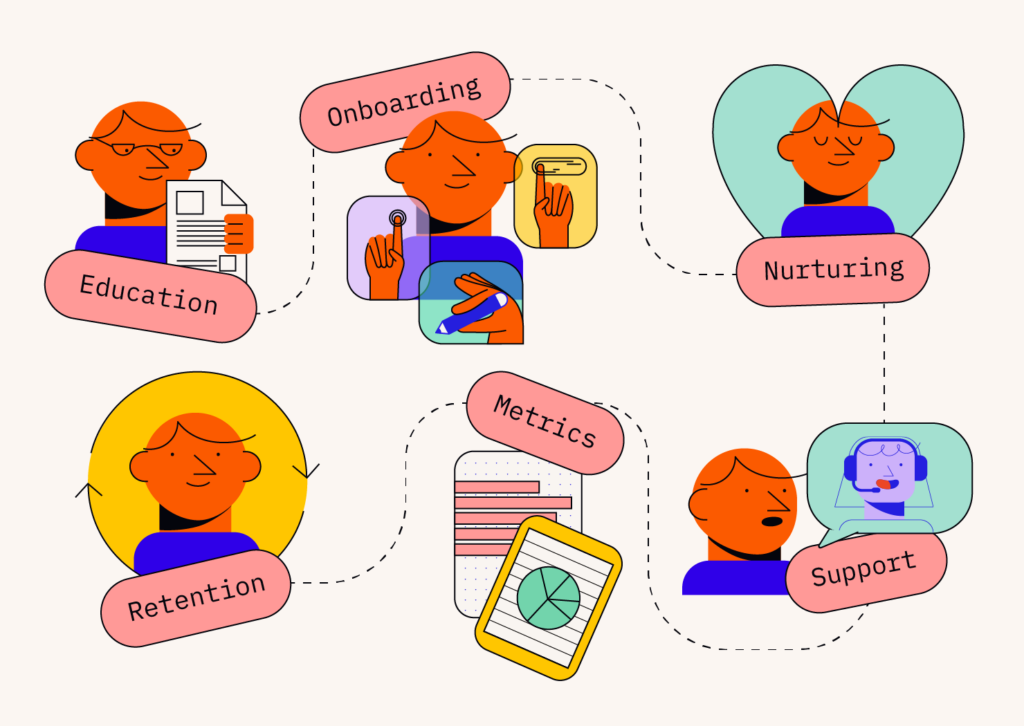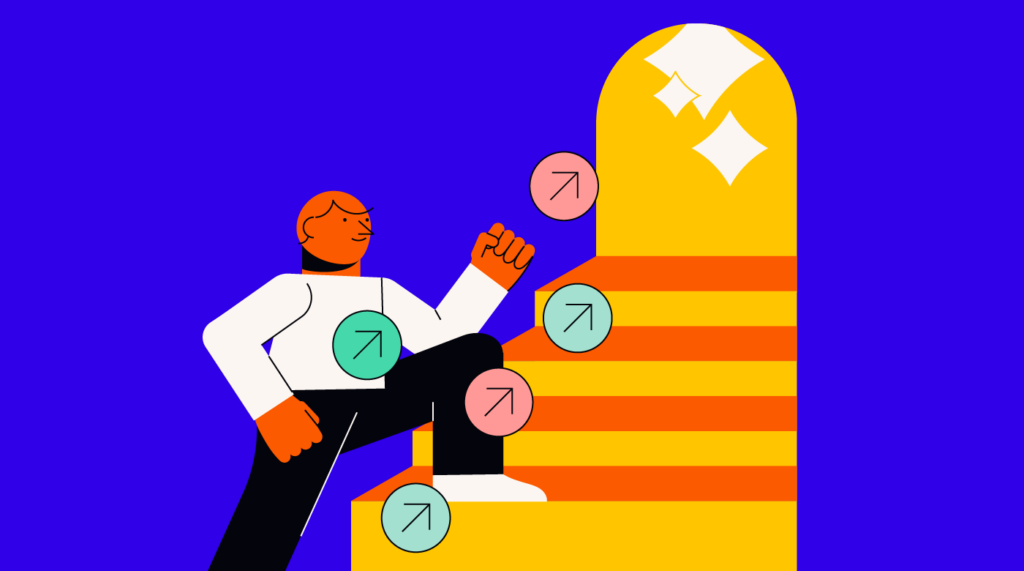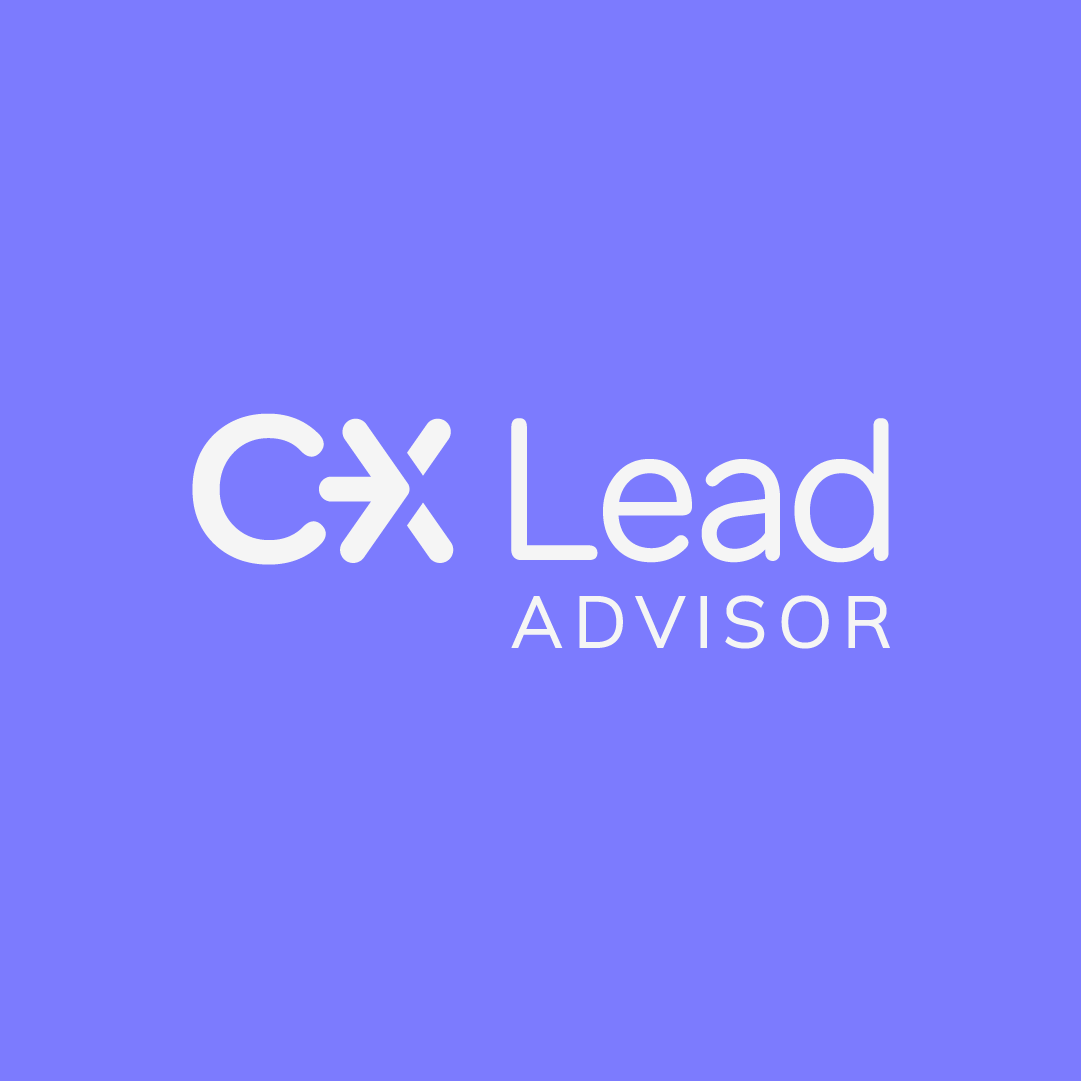Designing a solid customer success process may be the single best thing you can do for your business. 75% of customers will spend more money on good customer experience, according to Zendesk, while Harvard Business Review says retaining a customer is 5 times cheaper than acquiring a new one. One thing’s for sure: the customer success process you use can drive considerable value—or, it can cause your company to bleed revenue and customers.
And that’s particularly impressive because on their own, the components of the customer success process don’t seem revolutionary. Customer education, onboarding, support, nurturing—these feel like the bare minimum rather than a system to skyrocket your growth.
But many businesses don’t plan for customer success. Two out of three businesses have no strategy for preventing customer churn. Whether your business is in that category or not, you’ll want to read on—because improving your customer success process is your ticket to higher customer lifetime value, reduced churn, and faster growth.
What Is a Customer Success Process?
The customer success process describes the system you use to keep customers happy by providing value and support after the sale. Even if you think you don’t have a customer success process, you do—it may just be an unorganized one.
A disorganized customer success process looks like this:
Your company focuses more on customer acquisition than retention. You don’t have a strategy to reduce churn. Onboarding doesn’t give customers immediate value. There isn’t much communication after onboarding. Customers feel neglected and ultimately churn.
Of course, this isn’t what we want.
A healthier customer success process looks like this:
Your company educates prospects before the sale, using messaging, branding, and pricing to attract the right kind of customer. Onboardings are tailored to provide an immediate “Aha! moment” of value. The customer success team has frequent touchpoints with customers and incorporates customer feedback into the product. Customers become advocates and send you referrals.
Whatever your current customer success process looks like, make sure you document it as a standard operating procedure (SOP) or within your customer success software. Then, as you optimize it over time, update your workflow.
How Your Customer Success Process Drives Growth
A well-designed customer success process means customers are retained longer and spend more. Because happy customers have a higher lifetime value and are more likely to send referrals your way, your business grows faster. According to Harvard Business Review, increasing retention by 5% increases profits by 25% or more.
Startups and small businesses often lack a process for managing the customer experience after the sale. But it’s often these businesses that need to focus on customer success the most. Existing customers are the lifeblood of small business and the growth engine for startups. While small companies don’t always need corporate-level SOPs, make sure to map out a strategy that helps customers get value fast—and stay happy.
As your business grows, all kinds of issues can surface: organizational bloat, scattered focus, aggressive competitors. Without a solid customer success process, your customers may feel neglected—especially if your company struggles to hire fast enough to keep up with the growth.
Rather than letting each individual customer success manager (CSM) set the playbook for how customer interactions work, a good customer success process takes a 30,000-foot view to make sure touchpoints are consistently positive—and that customer frustrations are anticipated and dealt with quickly.
Designing A Customer Success Process

To design a process that drives adoption and reduces churn, you’ll need to get these parts of the customer experience right: education, onboarding, nurturing, support, metrics, and retention. Let’s dive into each below.
Customer Education
As marketers and CX professionals, why do we forget our own experience when designing processes? We often harbor the fantasy that customer journeys are linear and logical. Personally, I’d love it if the buyer’s journey went like this: prospects hear about your company, sign up for your webinar, jump on a sales call, and—poof—you’ve got a sale. But that’s not how it usually works.
Make sure you’re thinking like a customer. For example, when I make a purchase, there’s often a massive lag time between discovering a product and taking action. I’ll follow the company on social media. Retargeting ads will pull me back to the websites. I’ll join the email list. Emails will direct me toward a video or webinar. Eventually, I’ll search for reviews and comparisons before making the decision to sign up.
What this means is that customer relationship management starts long before the sale happens. For customers who linger before making a decision—consuming your content in the meantime—you’ve got an opportunity to influence their success ahead of time.
This period of pre-sale customer education is your chance to:
- Communicate your values.
- Attract ideal-fit customers who are more likely to stick around longer.
- Set product expectations. The blog posts and webinars your customers consume pre-sale can prime them on how to get value out of your product quickly.
If your messaging attracts the right customers and primes them for success, every other piece of the customer success process becomes easier.
Related read: Best Customer Messaging Platforms for Teams
Customer Onboarding
When I worked as a customer success manager, I ran onboarding sessions. My goal was to set expectations and help customers get a quick win. But our onboarding meetings did double duty—they also served as handover meetings from sales to customer success. Often, the priorities of the handover—building rapport, making the customer feel comfortable—took priority over the onboarding itself.
Onboarding is a time of conflicting priorities. It’s an exciting but jarring time for customers. They’ve bought and paid for your product, and they’ll never be more optimistic than they are now—but they still need reassurance that they made the right decision. They’re probably also being juggled between departments, so there’s a chance they’ll fall between the cracks.
Your job during this phase is twofold:
- Build a flawless transition from sales to onboarding.
- Set expectations and help the customer get an “Aha! moment” of value.
The hardest part to get right is the “Aha! moment.” According to a survey by RocketLane, onboarding most commonly fails due to slow time-to-value. But not every customer will find the same things valuable. That makes it harder to design a standard process.
With a high-touch onboarding process, the way to get the “Aha!” right is to instruct your CSMs to listen. Make sure they understand customer needs and let that drive the onboarding session. From a process standpoint, a flowchart is one way to handle this—if customers value a certain outcome, make sure to demonstrate features that enable that outcome during the onboarding.
You can do this with a low-touch customer engagement process too. Rather than giving the same automated onboarding experience to everyone, include prompts that ask customers a couple of questions. Use their answers to drive a more customized self-serve onboarding experience. Then, use segmentation and automation to help customers continue to make progress on whatever’s important to them after onboarding.
Nurturing
Nurturing is the process of growing the customer relationship after onboarding. It’s a way to improve the customer experience, increase retention, and create successful customers who turn into advocates. Nurturing also grows customer value over time through upsells and cross-sells, since the probability of selling to an existing customer is 60-70%.
Adding nurturing to your customer success strategy means increasing the number of meaningful touchpoints you have with each customer. Boilerplate company newsletters won’t help here.
Instead, you’ll want to:
- Set up regular check-ins like calls or emails.
- Recognize professional (and personal) milestones.
- Ask for feedback so customers feel like they’re being heard.
- Give customers exclusive previews and early “VIP” access to new products.
- Create educational content that helps customers get more value out of your product.
The key to nurturing is to take your customer relationships from functional to emotional. Design a process that helps your customers feel valued and recognized—which will help them forge a closer connection with your brand and your team..
Customer Support
If your company drops the ball on routine customer support, your efforts at turning customers into advocates won’t go anywhere. Great customer support is a prerequisite for growth.
The first rule of customer support is prevention. By making sure your product is easy to use, you can stop issues before they happen. When issues do happen, make it easy to find solutions in your knowledge base. Most customers prefer self-service—81% of customers try to fix problems on their own before they ever reach out to customer support.
By the time customers contact your support team, they’ve already encountered two annoyances—they have an issue with your product, and they couldn’t find a solution in your knowledge base. What they need is a fast solution with minimal pain.
Your customer support team should be:
- Available cross-channel—by phone, chat, and social media
- Active 24/7 (depending on the expectations in your industry)
- Trained to listen and respond with empathy
- Ready with solutions to all common issues
Reduce customers’ pain by reducing wait time. Make sure the person they reach helps them resolve the issue, rather than transferring them to another department. If you have a high-touch customer support approach, customers should be able to reach their CSM directly by phone or email.
Customer Success Metrics
Designing a customer success process should lead to a better customer experience. But when it does, how will you know? Customer success metrics are the answer. By surveying your customers and tracking their interactions with your company, you can map trends that show whether your efforts are paying off.
Metrics to consider include:
Customer Effort Score (CES)
Customer Effort Score (CES) measures the difficulty customers experience when interacting with your company. A high CES means customers struggle to get what they need. A low CES means customers don’t go through much effort. CES is measured by asking customers to agree or disagree with the statement: “[Company] made it easy for me to handle my issue.” Customers answer on a scale from 1-7.
Net Promoter Score (NPS)
Net Promoter Score (NPS) measures answers to the question: “On a scale of 0 to 10, how likely are you to recommend this product/company to a friend or colleague?” Companies with a high NPS have been shown to grow faster than their competitors.
Customer Satisfaction (CSAT)
Customer Satisfaction Score (CSAT) is a key customer health score that shows how happy customers are with your company. CSAT measures answers to the question, “How would you rate your overall satisfaction with the [goods/service] you received?” Customers answer on a scale of 1-5.
Related read: Best Customer Satisfaction Software
Average Resolution Time
Average resolution time measures how long it takes for a customer’s issue to be resolved. This is a valuable metric to watch because it measures something customers care about—how much of their time is wasted.
Churn Rate
If you’re improving the customer experience, your churn rate should go down. If it’s not going down, the things you’re doing aren’t meaningful enough to stop customers from quitting. Churn rate is a key metric when connecting your customer success efforts to revenue.
Customer Lifetime Value (CLV)
Customer Lifetime Value (CLV) measures how much money the average customer spends with your business throughout the customer lifecycle. As your customer experience improves, your CLV should go up.
Don’t feel like you have to use every methodology that’s available. If you track NPS and CSAT but not CES, you’ll be fine. Just focus on the ones that provide actionable data for you.
Related read: Best Customer Data Platform
Retention
Retaining customers is an existential issue for companies. US companies lose a total of $1.6 trillion per year from customer churn, according to Accenture. The “leaky bucket” analogy is appropriate here—it’s hard to justify chasing new customers when a high percentage of them are slipping through your fingers.
If you’re experiencing high churn, the first thing to do is figure out why customers are leaving. Common reasons for churn include poor customer fit, weak customer support, product or UX issues, and slow time-to-value.
You’ll mainly want to look at trends across your account as a whole. But it’s also worthwhile to look at individual accounts as case studies. Figure out where the relationship started to go wrong and when the “point of no return” happened.
A combination of customer data analysis and anecdotal review will take you to the next stage: a plan to improve customer retention. Don’t try to tackle everything at once. Focus on the areas of your customer experience that are causing the most churn. Fix those first.
Here are few strategies to reduce churn:
Attract ideal-fit customers
Some customers were never a good fit. By bringing them on, you invite high churn rates because inevitably, they’ll discover that your product isn’t right for them.
You can signal who your target customer base is by tweaking the messaging and branding you use in your marketing. You can also attract different types of customers by changing your product’s pricing.
If you have a high-touch sales process, consider setting up an incentive structure that rewards retention in addition to sales.
Help customers get value faster
Immediately after customers sign up is a risky time for churn. They’re excited to start using your product, but they’ll be turned off if they don’t find what they need—and fast.
For low-touch onboarding, make sure you optimize your welcome emails, first log-in experience, and onboarding sequence. Create an interactive walkthrough to guide customers on the best ways to get value. This is particularly important for SaaS companies.
For high-touch onboarding, make sure your CSMs ask questions and listen to customers rather than launching into a boilerplate product demonstration. By hearing what’s important to customers, your customer success team can focus on the aspects of the product that are most useful to them, getting them closer to an “aha moment” that solidifies the value of your product. Find the right software for improving your customer experience and interactions.
Watch how customers use your product
Product and UX issues vary, but the solution is usually the same—ask customers what changes they need, then make those changes. You also want to watch how customers are interacting with your product so you can find points of frustration. Heatmaps and screen recording tools can help with this.
Solve support issues quickly
Your knowledge base is one of the most critical customer support assets you have. Make sure you’re turning every unique customer inquiry into a knowledge base article. Over time, the volume of support inquiries should go down as more customers self-serve. Lower volume alone may help your customer support experience, since each support rep will manage fewer tickets.
Make sure your support team is focused on one goal above all—solving the customer’s issue fast. Track metrics like Average Resolution Time and talk to your team members to understand what’s stopping them from resolving customer problems faster.
Set better customer expectations
Customers don’t always have reasonable expectations. But there are a few ways you can influence their ability to get their desired outcome.
- Set expectations properly up front. Service businesses and high-touch product businesses should use their sales and onboarding processes to set expectations.
- Ongoing education. Once you’ve set reasonable customer expectations, use your nurturing sequence to send them a steady stream of educational materials. Focus on actionable materials that get them closer to reaching their goal.
- Celebrate with customers when they’ve reached their desired outcome. Build milestones and recognition into your process to remind customers how far they’ve come.
Put Churn in the Rearview Mirror
If you’ve gotten this far, you’re on your way to saying “goodbye” to high churn and “hello” to loyal customers. Don’t worry if your current customer success process needs work. Take stock of where you are, identify your biggest areas for improvement, and get started.
And remember—your customer success process isn’t set in stone. You’ll want to revisit it at least annually, since metrics and customer feedback change over time.
Wondering how else you can level up your CX game? Subscribe to our newsletter and stay up to date with the latest CX industry trends and tips.
You might also like: 10 Best Customer Success Software
Need expert help selecting the right Customer Experience Software?
If you’re struggling to choose the right software, let us help you. Just share your needs in the form below and you’ll get free access to our dedicated software advisors who match and connect you with the best vendors for your needs.



